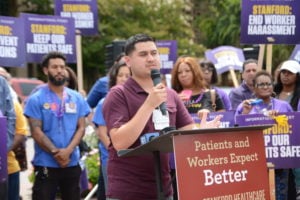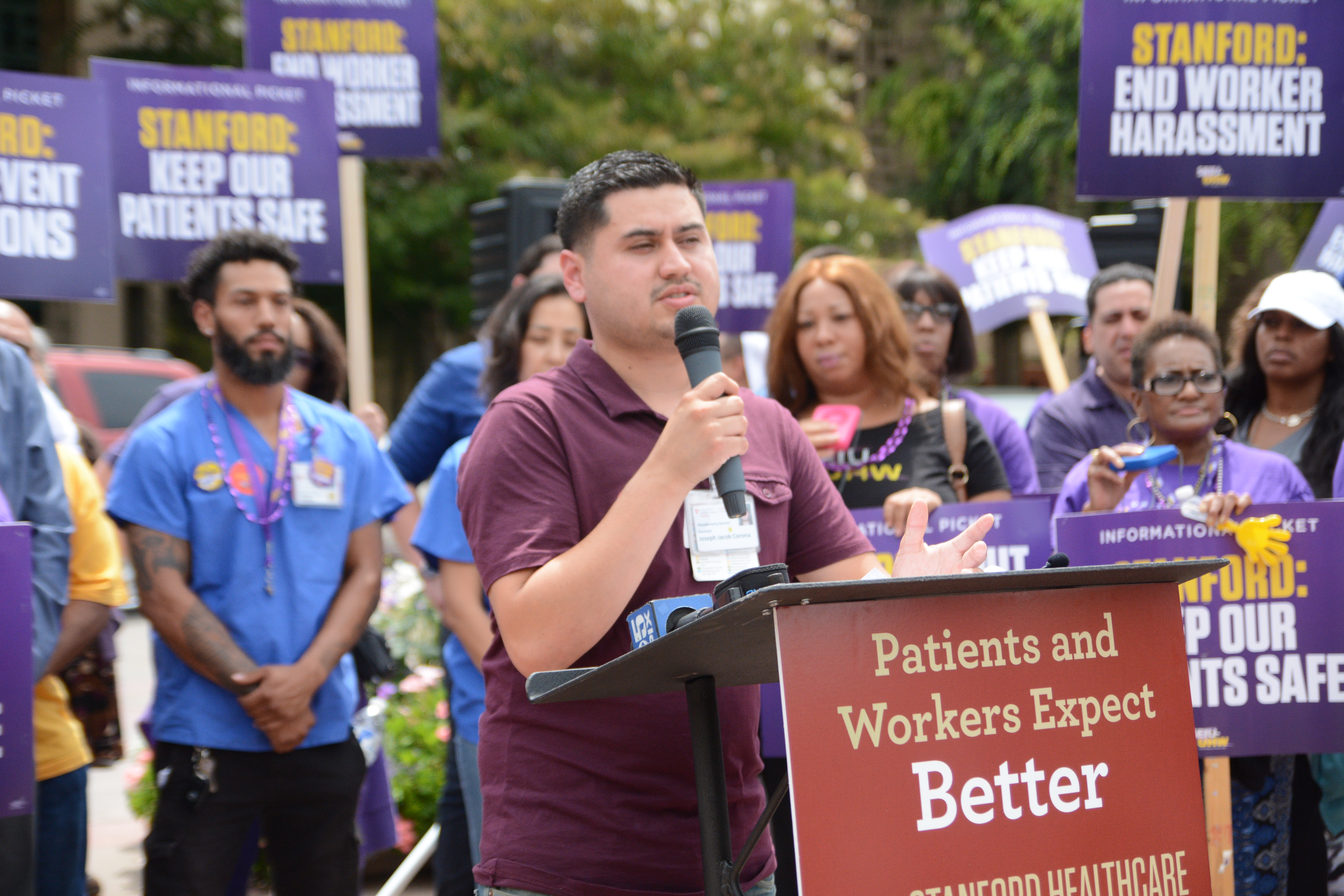
Hundreds of demonstrators from all over California showed up in support of frontline workers at Stanford Medical Center. Armed with purple banners, megaphones and noisemakers, they chanted “Stanford, Stanford, you can’t hide, we can see your dirty side!” as they paraded around the hospital’s entrance.
Meanwhile, Stanford Health Care (SHC) is trying to reach agreement with the union workers, participating in meetings and negotiations to work with union demands.
This picket was organized by the Service Employees International Union – United Healthcare Workers West (SEIU-UHW), one of the largest unions of hospital workers in the western United States, voicing allegations of worker intimidation. Complaints arose from a union-organized July 11 press conference to apparent concerns over irregularities in worker training and sanitation policy.
Hospital administration created a website dedicated to informing the public of the negotiation process that started July 15. The most recent meeting was held on Aug. 2. An official Stanford Health Care/Stanford Children’s Health media statement has been issued in response to this picket. Additional negotiations are planned for Aug. 9, 16 and 23. The current union contract expires on Aug. 29.
SEIU-UHW claims intimidation
On July 26, 2017, SEIU-UHW organizers joined a National Labor Relations Board charge against SHC, alleging that union-affiliated employees were harassed, threatened and intimidated for their role in a July 11 press conference discussing infection rates at the hospital.
Joseph Corona, a housekeeping assistant at SHC who participated in the July rally, claimed to have been the subject of scare tactics by management for his role in the issue.
“After speaking at the July press conference, I received more attention from management and security,” Corona alleged. “[They] started ordering security guards who were pretty big in size to approach me in negative, aggressive ways to intimidate, distract, even stalk myself and other people who provided information.”
Tom Parker, a spokesperson for the SEIU-UHW, alleged that workers were prevented from attending the Aug. 3 informational picket.
“I only have it second-hand, but I’ve been told that workers, particularly in the housekeeping department, were told that they couldn’t come out. The only way they could come to the picket is if they were on their break or off their shift,” Parker said.
The claim was repeated by several other union demonstrators at the rally. Although 500 people were expected to participate, organizers estimated the crowd top off at 300.
SHC Corporate Communications and Media Lead Patrick Bartosch said the union has previously pressured SHC to meet union demands, dismissing allegations of SHC preventing employees from picketing and accusing the SEIU of bringing in outside demonstrators to misrepresent hospital staff.
“Similar to the union’s July 11 press conference where it released misleading and outdated information about our infection rates, the informational picket is another example of SEIU-UHW trying to put pressure on the Hospitals to meet its organizing demands,” Bartosch wrote in an email to The Daily. “In an attempt to grow the union’s event, we heard SEIU-UHW bused in additional people from the surrounding areas to join.”
Union alleges sanitary problems
For the second year in a row, the hospital has had its Medicare subsidies reduced by the Center for Medicare Services (CMS) for infection-related issues, according to Healthcare Finance and the CMS website. On a CMS scale of the number of hospital-acquired infections with ten being the worst level of infections, SHCHC scored a seven out of ten.
One of these major concerns is of Clostridium difficile (C. diff), a bacteria that causes inflammation of the colon and can lead to extreme diarrhea, abdominal pains, nausea and fever. The bacteria is spread through contact with infected area and can live for long periods of time on surfaces.
The problem is that patients have been acquiring the disease after being admitted into the hospital for other infections.
In a Feb. 2016 article, however, Lucy Becker Professor in Medicine and Microbiology and Immunology Lucy Tompkins attributed high C. diff rates to a more stringent test, a fact that government regulatory bodies do not include in their data.
Union members alleged that these issues arise from poor training and education, chronic understaffing and communication issues. In the Aug. 3 press conference, several SEIU members shared their concerns with management policy.
Salyna Nevarez, an SHC phlebotomist, spoke about how understaffing leads to cutting corners.
“I’ve witnessed employees of all ranks fail to follow infection control policies, I’ve witnessed employees removing their [personal protective equipment] incorrectly after moving out of an isolation patient room, resulting in cross-contamination,” Nevarez said. “I’ve walked into an improperly marked room containing a patient with C. diff, and I didn’t know until the nurse told me. These are preventable mistakes.”
Nate Anderson, a transporter who moves patients in and out of the hospital via gurneys, spoke about a transition from bleach wipes to alcohol wipes and OxyCide. When he questioned the effectiveness and availability of these new cleaning materials, he claimed to receive unsatisfactory answers from his directors and managers.
“If you ask three different people what’s the right infection prevention protocol, you’ll get three different answers: this has consequences,” Anderson stressed. “They’ve tested me for tuberculosis three times in a year and a half because of fears of exposure. It puts workers like me at risk, but more importantly, it puts our patients at risk.”
SHC responded to charges of quality issues by pointing toward distinctions in other metrics.
“SHC’s Standardized Infection Ratio score actually exceeds the industry benchmark at preventing infections,” wrote Bartosch. “We are extremely proud of SHC’s overall quality rating, which summarizes up to 57 quality measures and provides a hospital performance rating between 1-5 stars.”
Negotiations and politics
The union rally received support from several local elected officials. Vice-mayor of East Palo Alto Ruben Abrica attended to show his support for the union’s efforts.
“I’m here to express my support and congratulate you on taking care of all people who need help,” Abrica said. “Obviously, all jobs are important. But there’s something about this one in particular where you’re dealing with people and their health. You’re risking your own health, and that’s just not right.”
Ultimately, however, negotiations must occur between SHC and SEIU-UHW leadership.
Linda Cornell, a unit secretary at the hospital and prominent speaker for the union, claimed that the hospital officials have neglected SEIU demands.
“We initially tried to set up a meeting with the CEO and he agreed, but then he sent a message back to us [with] restrictions: the meeting would be with HR, not the CEO; that he was going to restrict who could be at the meeting and he was going to restrict what could be talked about,” Cornell said.
Medical center officials, on the other hand, iterated their commitment to a fair bargaining process. Bartosch explained that they have had seven bargaining sessions so far, offering economic improvements and careful consideration of SEIU-UHW proposals.
“Our pledge throughout these negotiations is to bargain in good faith to reach a mutually acceptable agreement that provides wage increases and other improvements that support our employees and their profession,” Bartosch wrote.
This article will be updated with further comment from SHC administration.
Correction: A previous version of this article misstated Joseph Corona’s title as an Employee Benefit Specialist, when Corona is in fact a housekeeping assistant, or Environmental Services worker (EVS). Additionally, spokesperson Tom Parker was incorrectly listed as community organizer Tony Parker. The Daily regrets these errors.
Contact Matthew Lee at 18matthewl ‘at’ students.harker.org and Jessica Zhang at jessica ‘at’ stanforddaily.com.
